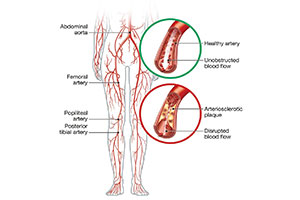Tests, treatments for peripheral arterial disease
Sep 29, 2022
Teresa URQUHART
CEO, Palm Beach Gardens Medical Center
September is National Peripheral Arterial Disease (PAD) Awareness Month, a yearly reminder to learn about prevention of this vascular condition, signs, and symptoms of PAD, and treatment options available today. Peripheral arterial disease, a vascular disease, causes blockages in the arteries of the legs due to cholesterol and fats building up causing plaque to form and prohibit regular circulation or blood flow. Approximately 8.5 million adults in the U.S. alone have PAD, including 12% to 20% of individuals older than age 60. The Heart & Vascular Institute at Palm Beach Gardens Medical Center uses some of the latest technology to deliver quality, comprehensive care to our patients with diseases of the vascular system — the arteries and veins.
Plaque obstructs important nutrients and oxygen from transporting to leg arteries, muscles and tissues, and can cause limb cells to die. In some of the more severe cases of PAD, pain in the legs can develop and lead to a more serious condition known as critical limb ischemia (CLI). Delay in care for CLI can lead to amputation. Up to 2 million people suffer from CLI. Vascular surgeons at the Heart & Vascular Institute at Palm Beach Gardens Medical Center use advanced technologies and procedures, including vascular surgery, endovascular surgery, and venous surgery, to treat a wide range of cardiovascular conditions.

Peripheral arterial disease PAD, a vascular disease, causes blockages in the arteries of the legs due to cholesterol and fats building up causing plaque to form and prohibit regular circulation or blood flow.
Several risk factors can lead to the development of PAD, including smoking, diabetes, obesity, age (55 years old and up), hypertension, high cholesterol, family history of coronary artery disease (CAD), peripheral vascular disease (PVD) or stroke.
According to the Centers for Disease Control and Prevention (CDC), the signs and symptoms of PAD include pain in the legs with physical activity, such as walking, that gets better after rest. However, up to 4 in 10 people with PAD have no leg pain. Symptoms of pain, aches, or cramps with walking (claudication) can happen in the buttock, hip, thigh, or calf. Physical signs in the leg that may indicate PAD include muscle atrophy or weakness, hair loss, smooth, shiny skin, skin that is cool to the touch, especially if accompanied by pain while walking (that is relieved by stopping walking). Other signs of PAD include decreased or absent pulses in the feet, sores or ulcers in the legs or feet that do not heal and cold or numb toes.
If you have some of the risk factors or signs and symptoms of PAD talk to your doctor about being tested for the disease and ways to prevent from the condition getting worse. Early screening for PAD can include noninvasive diagnostic testing such as an ankle-brachial index, segmental limb pressures, pulse volume recordings, and arterial duplex. Computer tomography angiography (CTA) and angiography are also tools used to diagnose PAD in the hospital setting. Losing weight, eating healthy, getting exercise, maintaining a healthy weight, and not smoking may reduce the risk of vascular disease and help to prevent further problems after diagnosis. When PAD requires treatment, your vascular surgeon may recommend lifestyle changes, medications or endovascular surgical treatment with balloons and stents.
To learn more about vascular care at Palm Beach Gardens Medical Center, visit www.pbgmc.com/services/cardiovascular or call 561-622-1411.Source: https://palmbeach.floridaweekly.com/articles/tests-treatments-for-peripheral-arterial-disease/?fbclid=IwAR3oc_mPc-gdC7w0GYz_rxkh-F7OKtUV2LKcBQiSXqDx4JMyEJKEglMLiog


